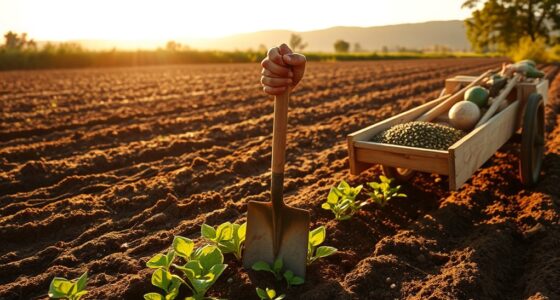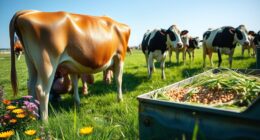Commercial farming means producing crops and livestock for profit on a large scale. You'll often see advanced technology and machinery at work, maximizing efficiency and meeting market demands. This type of farming includes various practices like dairy, livestock ranching, and grain farming. While it boosts economic growth and food supply, it also brings challenges like high costs and labor issues. If you're curious about its environmental impact and future trends, keep exploring the topic!
Key Takeaways
- Commercial farming is the large-scale production of crops and livestock aimed primarily at generating profit and meeting market demands.
- It employs advanced technology and machinery, enhancing efficiency and yield through practices like precision farming and biotechnology.
- The sector significantly contributes to the economy, representing about 4% of global GDP as of 2018, while ensuring food security.
- While it boosts production, commercial farming can lead to environmental issues such as soil degradation and water pollution.
- The practice faces challenges, including high capital requirements, labor exploitation, and vulnerability to market fluctuations and crop failures.
Understanding Commercial Farming
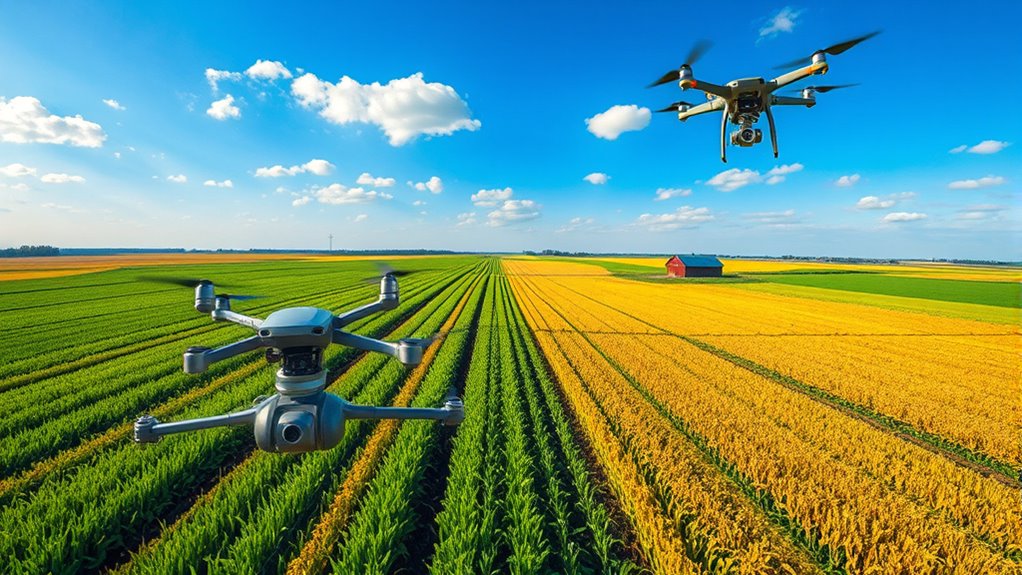
Commercial farming is a vital aspect of modern agriculture, focusing on producing crops and livestock primarily for sale and profit.
Commercial farming plays a crucial role in agriculture, emphasizing the production of crops and livestock for profit.
You'll find these large-scale operations often span thousands of acres, leveraging advanced machinery to boost productivity. With cutting-edge technology like precision farming and biotechnology, farmers enhance yields and streamline processes.
This sector significantly contributes to the global GDP, accounting for around 4% in 2018, and creates numerous jobs in food processing, transportation, and retail.
However, it's crucial to consider the environmental implications, as intensive farming practices can lead to soil degradation and water pollution.
Balancing profit with environmental responsibility is essential for sustainable growth in commercial agriculture.
Key Features of Commercial Farming
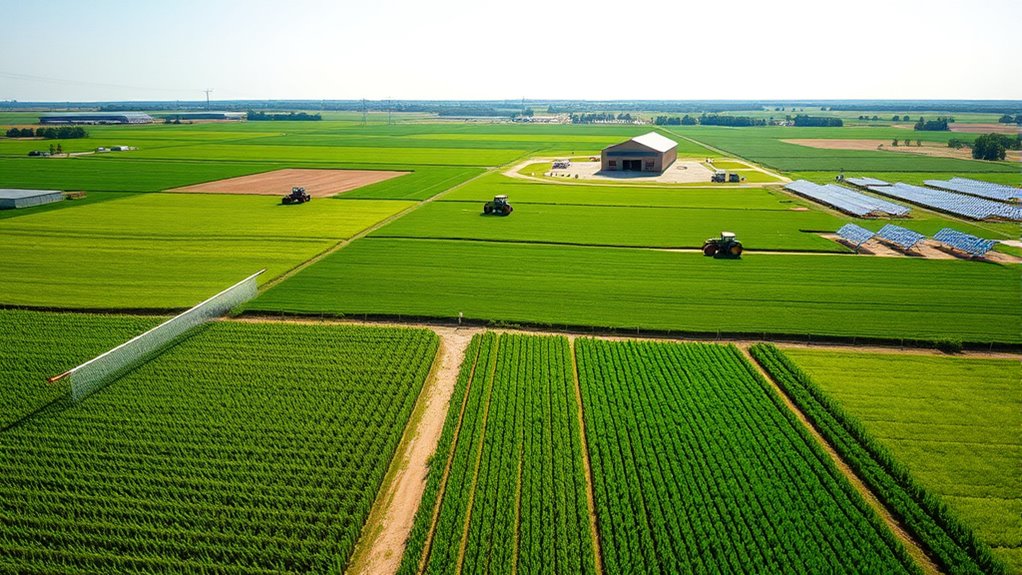
While exploring the key features of commercial farming, you'll notice that large-scale production stands out as a fundamental characteristic. This type of farming operates on vast tracts of land to meet market demands, providing raw materials for industries and exports.
You'll also find that substantial capital investment is crucial; advanced technology and modern equipment boost productivity. With high-yielding varieties and skilled labor, efficiency increases significantly.
Additionally, commercial farmers focus on crop selection based on market demand, aligning their production with consumer preferences. Year-round production is made possible through artificial irrigation and sustainable practices like crop rotation, ensuring long-term viability.
Types of Commercial Farming Practices

Farming practices today come in various forms, each tailored to meet specific market demands and environmental conditions.
You might consider dairy farming, where farmers rear cows or goats for milk production, especially in countries like New Zealand and Ireland.
Livestock ranching focuses on raising animals like cattle and pigs for meat, with efficient management supported by software.
Grain farming involves large-scale cultivation of crops like wheat and corn, often relying on heavy machinery and favorable climates.
Plantation farming, historically linked to colonialism, now emphasizes cash crops like tobacco and coffee.
Finally, integrated farming systems blend crop cultivation with livestock rearing, promoting sustainability through recycling animal waste as fertilizer.
Each method has unique characteristics suited to different markets.
Advantages of Commercial Farming
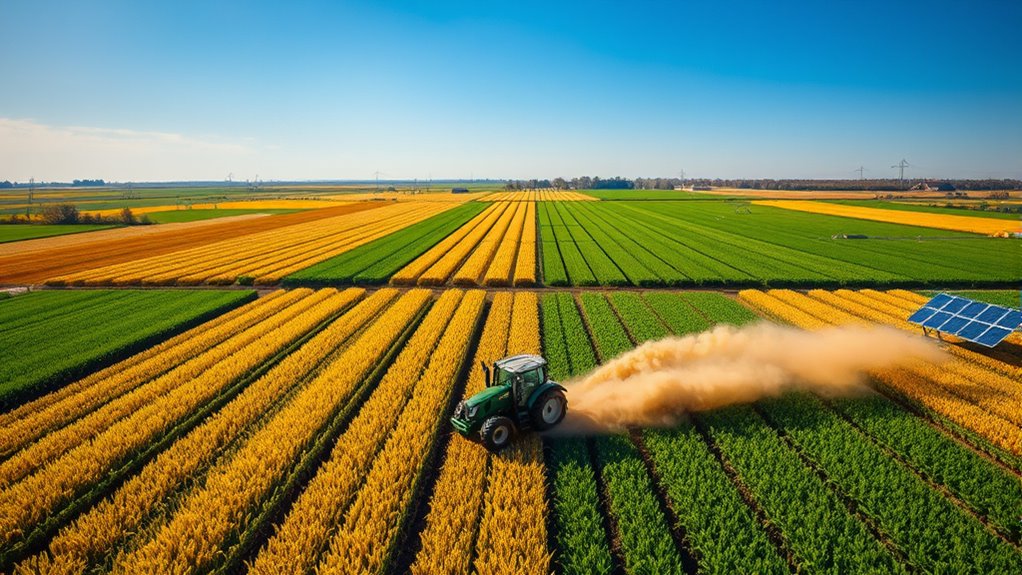
When you consider the advantages of commercial farming, it's clear that this approach significantly boosts economic growth and food production.
You'll find job creation in both urban and rural areas, allowing communities to thrive. By engaging in large-scale production, farmers can increase their income and meet market demands effectively.
This model ensures consistent food supply, contributing to global food security. Advanced technologies, like precision farming and automation, enhance efficiency while reducing operational costs.
Moreover, commercial farming promotes environmental sustainability through practices that improve soil health and conserve water.
Disadvantages and Challenges
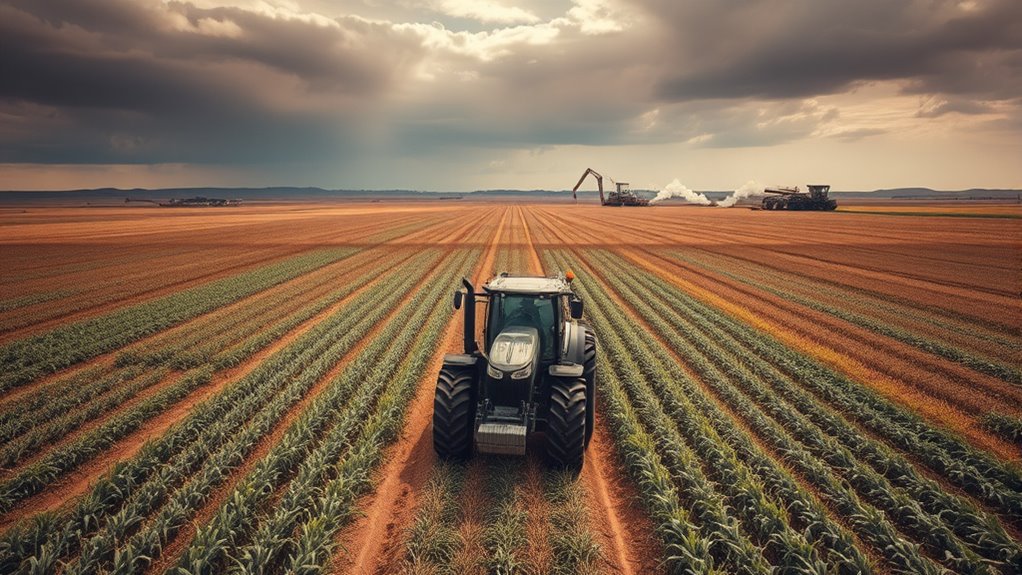
Despite the numerous advantages of commercial farming, it comes with a range of disadvantages and challenges that can impact both farmers and the environment.
You'll find that high capital requirements for machinery and inputs can strain your finances. Labor concerns also arise, as workers often endure long hours and low wages. Market fluctuations can lead to instability, while monoculture practices heighten vulnerability to crop failures.
High capital demands and labor issues create significant challenges in commercial farming, impacting both financial stability and worker well-being.
Additionally, inadequate technical know-how can hinder operations. Resource management poses challenges too, with soil degradation and waste management issues affecting productivity.
Lastly, social implications, such as labor exploitation and community displacement, can emerge, making it crucial to navigate these challenges carefully for sustainable success in commercial farming.
Environmental Impact of Commercial Farming
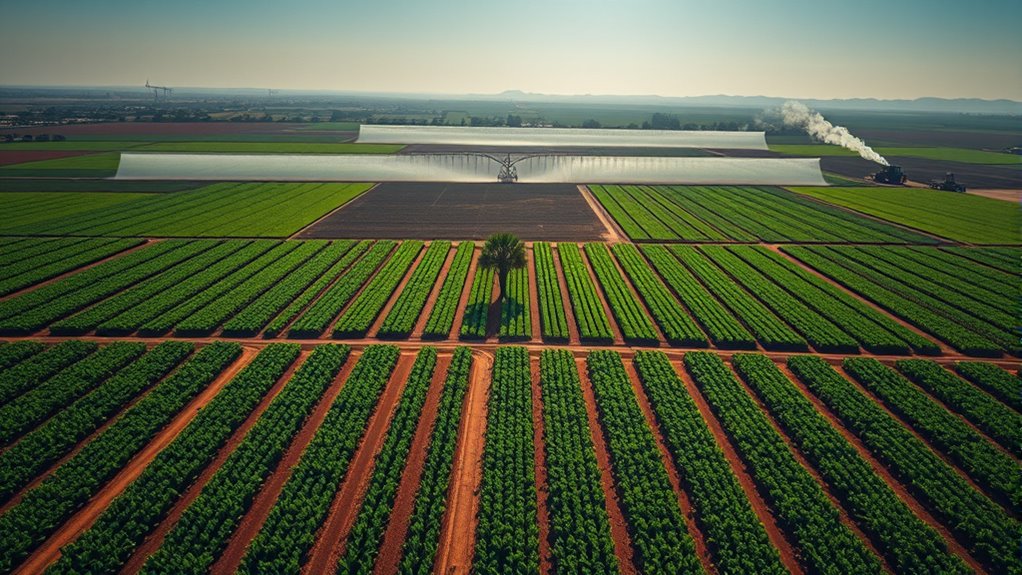
Commercial farming significantly affects the environment, often exacerbating issues highlighted by the challenges faced by farmers. Deforestation for crops like soy and palm oil leads to habitat loss and biodiversity decline, releasing carbon and contributing to climate change.
You mightn't realize that agriculture consumes about 69% of the planet's fresh water, straining vital resources. Runoff from fertilizers and pesticides pollutes water sources, posing health risks to both humans and aquatic ecosystems.
Additionally, livestock farming is a major source of greenhouse gases, accounting for about 18% of emissions. Unsustainable practices can degrade soil health, further threatening productivity.
It's crucial to consider these environmental impacts as we navigate the complexities of modern agriculture.
Economic Contributions of Commercial Farming
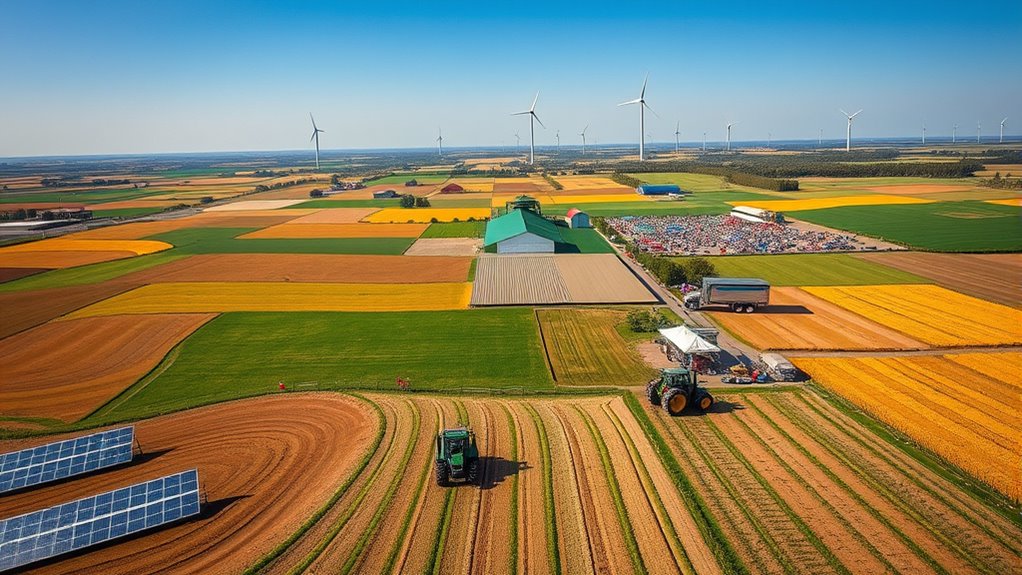
The economic contributions of commercial farming are vital to both local and national economies. In 2023, agriculture, including commercial farming, contributed around $1.53 trillion to the U.S. GDP, accounting for approximately 5.6%. This sector supports over 34 million jobs, extending far beyond traditional farming roles.
Moreover, U.S. agricultural exports reached $197.4 billion in 2022, stimulating significant economic activity. The ripple effects of agricultural spending bolster related industries like food services and transportation.
Future Trends in Commercial Farming
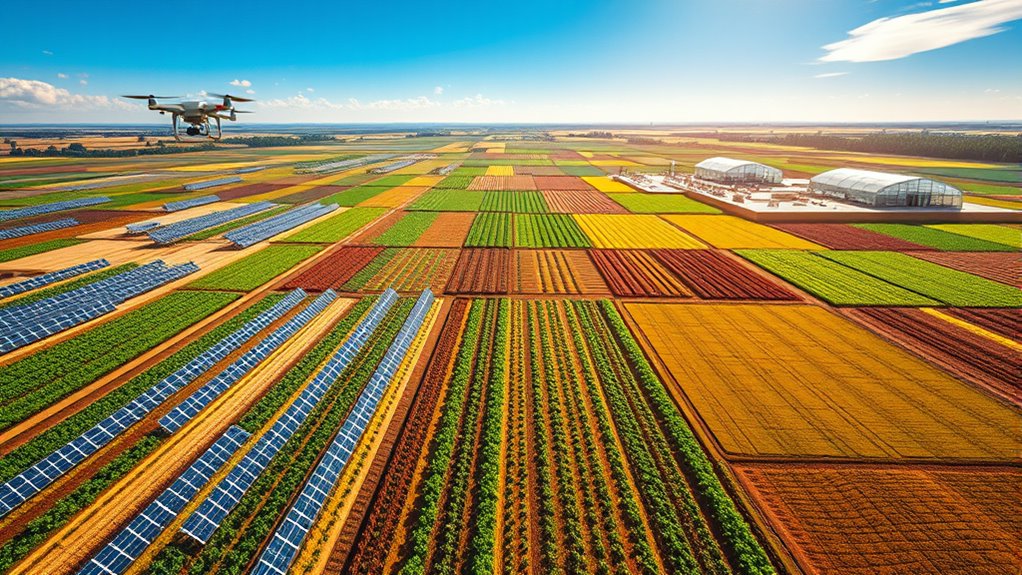
As the economic landscape of commercial farming evolves, several future trends are set to reshape the industry.
You'll notice precision agriculture taking the lead, integrating IoT and AI to optimize resources and enhance yields. Real-time monitoring through sensors will help you make targeted interventions, while predictive analytics can guide you in mitigating challenges like droughts.
Regenerative practices will also gain traction, focusing on soil health and promoting biodiversity, offering you sustainable income through carbon trading. The adoption of integrated pest management will be crucial in these practices to control pests naturally, reducing reliance on synthetic chemicals.
Controlled environment agriculture (CEA) will revolutionize production with year-round crops and water efficiency.
Lastly, the rise of alternative proteins and digital farming will diversify your offerings, enabling data-driven decisions for improved productivity and sustainability. Incorporating omega-3 sources like chia seeds can also enhance the nutritional value of your crops and appeal to health-conscious consumers.
Embracing these trends will position you for future success.
Frequently Asked Questions
How Does Commercial Farming Affect Local Food Systems?
Commercial farming affects local food systems in several ways. It creates competition that can squeeze local farmers out of the market, impacting their economic viability.
You might notice that large farms invest heavily in technology, making it harder for smaller operations to compete. While local farms can boost community engagement and food security, they often struggle against the efficiency and marketing power of commercial agriculture, which can shift consumer preferences away from local options.
What Role Do Consumers Play in Commercial Farming?
Ever thought about how your choices shape the food on your plate?
Consumers play a pivotal role in commercial farming by driving demand for specific crops and products. You influence what farmers grow, pushing them towards sustainability and quality.
Your preferences lead to diversification, as farmers adapt to meet your tastes. By supporting ethical practices and local producers, you help create a market that prioritizes both quality and environmental responsibility.
Your decisions truly matter!
How Is Technology Changing Commercial Farming Practices?
Technology's transforming commercial farming practices in remarkable ways.
You're seeing advances in machinery that boost productivity and precision farming techniques that enhance crop management.
With IoT and AI, you can monitor livestock and optimize irrigation efficiently.
Drones help you with tasks like spraying and surveying crops, while cloud computing enables real-time data analysis for better decision-making.
These innovations not only increase yields but also promote sustainable practices and economic growth in the agricultural sector.
What Are the Ethical Concerns Surrounding Commercial Farming?
They say, "You reap what you sow."
When it comes to commercial farming, ethical concerns abound. You might worry about animal welfare, as livestock often face poor living conditions and inhumane treatment.
There's also the environmental impact from chemical use and soil degradation.
Don't forget the labor issues; farmworkers often endure low wages and harsh conditions.
How Can Commercial Farming Adapt to Climate Change Impacts?
To adapt to climate change impacts, you can diversify your crops and livestock, spreading risk and improving soil health.
Implement precision agriculture technologies to optimize resources and reduce waste.
Embrace sustainable farming practices like crop rotation and conservation tillage.
Utilize climate-resilient crop varieties that withstand extreme weather.
Lastly, invest in advanced irrigation systems and accurate weather forecasting tools to make informed decisions, enhancing your farm's resilience against climate challenges.
Conclusion
In the ever-evolving landscape of agriculture, commercial farming stands as a double-edged sword—offering bountiful harvests while casting long shadows of challenges. As you navigate this fertile terrain, remember that the seeds of sustainable practices can bloom into a brighter future. By embracing innovation and responsibility, you can help cultivate an industry that not only feeds the world but also nurtures the planet. Let's sow the seeds of change together, ensuring a thriving agricultural legacy for generations to come.



